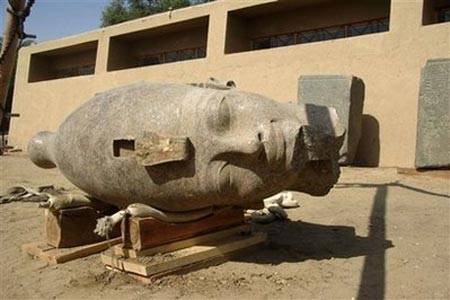Discovered the giant statue of the Egyptian king
Archaeologists have found a red granite head of a powerful Egyptian emperor who ruled about 3,400 years ago.

The giant stone head belongs to the statue of King Amenhotep III.Photo: AP.
The Supreme Council of Egyptian Antiquities yesterday announced that the stone head has a height equivalent to that of an ordinary person. According to the AP, it belongs to a statue of King Amenhotep III and is dug up in a ruined temple in the southern city of Luxor, Egypt. Dr. Hourig Sourouzian, the head of the temple excavation group, said that this is the most intact statue of Amenhotep III that archaeologists have found so far.
"The face of Amenhotep III on other statues always has something broken, such as the tip of the nose. But on this face, everything from the top of the crown to the chin is intact. It is carved and polished. very beautiful, there is not anything broken, " AP quoted Dr. Sourouzian.
The body and many other parts of the statue of Amenhotep III have been found many years ago. Archaeologists will soon match the head with the other parts.
Amenhotep III is the grandfather of the young emperor Tutankhamun. He ruled Egypt from 1387 to 1348 BC. Egypt was then in its peak, with territory stretching from Nubia in the south to Syria in the north. Nubia is an ancient country located in southern Egypt and northern Sudan today. After the 20th century BC it was annexed to Egypt.
Dr. Sourrouzian said that Amenhotep III is famous because under his rule, the Egyptians lived in peace and prosperity for several decades. Techniques of making art of Egyptian artisans also developed dramatically in the period that Amenhotep ruled. That explains why the features on the statue face are very symmetrical and beautiful.
"It is possible that the appearance of Amenhotep III is exactly the same as the statue's face. If that's the case, he is a handsome man , " Sourouzian said.
Much of the Amenhotep III temple was destroyed by floods, leaving only a few walls still standing today.
- Discovered the phenomenon of King Tut's grandfather
- The true body of the Pharaoh statue 3,000 years has been excavated
- Excavation of a huge Egyptian god statue 3000 years
- Discover the giant statue of the ancient Egyptian Queen
- Discovered the ancient Egyptian queen
- The 4,300-year-old head statue was smashed by Egyptian pharaohs
- Discovered the Pharaoh Ramsses II statue in Egypt
- Find the giant statue of Egyptian pharaoh Psamtik I
- Discovered the headless Greek king
- Discovering the statue of Queen Ti of Egypt
- Egypt announced two giant pharaohs
- New timeline for the beginning of ancient Egypt
 Discovered an ancient centipede fossil 99 million years old
Discovered an ancient centipede fossil 99 million years old Discovered bat-like dinosaurs in China
Discovered bat-like dinosaurs in China Discovered a 200-year-old bronze cannon of the coast
Discovered a 200-year-old bronze cannon of the coast Discover 305 million-year-old spider fossils
Discover 305 million-year-old spider fossils